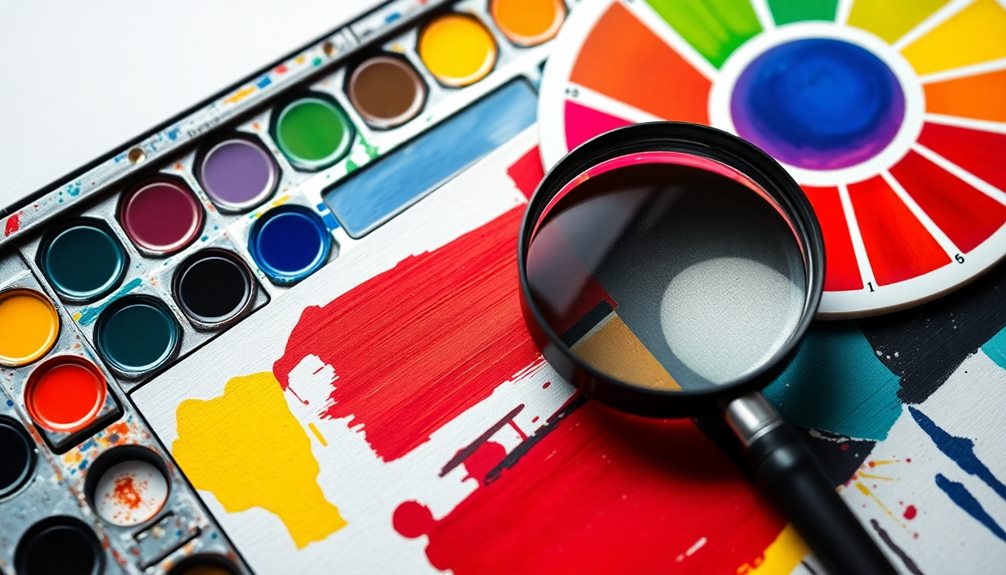In Formalist theory, composition is essential for shaping your emotional response to art. It's all about how the visual elements—like line, color, and texture—are arranged to create meaning and aesthetic value. By focusing on the structure and formal properties, you can appreciate the artwork beyond its subject matter. Artists such as Cezanne and Pollock exemplify this, showing how significant form evokes feelings through their compositions. The interplay of these elements not only generates emotions but also invites personal interpretation. If you explore further, you'll uncover even more insights into how composition influences your engagement with art.
Key Takeaways
- Composition is vital in Formalist theory, focusing on the arrangement of visual elements to evoke emotional responses and aesthetic appreciation.
- Significant form emphasizes that emotional impact arises from formal qualities, rather than the subject matter of the artwork.
- Effective composition relies on the thoughtful interplay of elements like color, line, and texture to create meaning and emotional engagement.
- Viewer interpretation of art varies, influenced by personal experiences and cultural backgrounds, enriching the artistic experience through diverse perspectives.
- Key figures in Formalist theory, such as Clement Greenberg and Clive Bell, shaped the understanding of composition's role in modern art critique.
Introduction

Composition often plays a crucial role in Formalist theory, shaping how you perceive and interpret art. You'll notice that the arrangement and relationship of visual elements like line, color, and texture are central to understanding an artwork's aesthetic value.
Formalist theory asserts that these elements convey meaning independent of the subject matter, allowing you to focus solely on the artwork's composition.
Significant form, a key aspect of this theory, emphasizes how the organization of these elements can evoke emotional responses. When you analyze a piece through a formalist lens, you see that the meticulous arrangement of color and form parallels musical composition, where structure and harmony matter just as much.
Prominent formalist critic Clement Greenberg championed the idea of self-reflexivity in art, urging you to concentrate on the formal properties that define each medium.
This focus on composition has profoundly influenced modern art criticism, providing a framework for dissecting how visual structure contributes to your interpretation and appreciation of art.
Key Concepts and Definitions

Understanding the key concepts and definitions within Formalist theory can significantly enhance your appreciation of art's visual elements. One of the most crucial concepts is composition, which refers to the arrangement and organization of visual elements like line, color, and texture. These elements are essential for creating aesthetic value in art. Understanding the key concepts and definitions within Formalist theory can significantly enhance your appreciation of art's visual elements. One of the most crucial concepts is composition, which refers to the arrangement and organization of visual elements like line, color, and texture. These elements are essential for creating aesthetic value in art. The formalist view on texture and pattern highlights the importance of how surfaces engage the viewer’s senses, emphasizing their role in evoking emotion and movement within a piece. By focusing on these intrinsic qualities, formalist theory allows us to analyze art independently of context or narrative, directing attention solely to the visual impact of its design.
Another key idea is "significant form," a term introduced by Clive Bell. This concept suggests that the emotional impact of a work of art arises from its formal qualities rather than its subject matter or context. In Formalist analysis, you'll focus on the intrinsic properties of a work, examining how compositional elements harmonize to create meaning and evoke emotional responses.
Clement Greenberg further championed the importance of composition, arguing that modern art should prioritize its formal aspects. He believed that self-reflexivity in composition is vital for distinguishing avant-garde art from kitsch.
Essential Elements of Composition

An effective composition hinges on the thoughtful arrangement of visual elements, such as line, color, and texture. In Formalist theory, these elements are essential for creating a work's meaning. The concept of "significant form," introduced by Clive Bell, emphasizes how aesthetic qualities in composition can evoke emotional responses from you, the viewer. By focusing on the interplay between these elements, artists can craft experiences that resonate deeply.
When you analyze a piece of art, it's crucial to look beyond narrative or contextual aspects. Formalism critiques these elements, urging you to prioritize the structural components of composition. Influential artists like Paul Cézanne and Jackson Pollock exemplified this approach, showcasing how visual relationships can take precedence over representational subject matter.
Think of the harmony and tension found in music; they parallel the dynamic relationships in composition. Each visual element contributes to the overall impact of the piece, making it vital to understand how they work together.
Famous Artworks Illustrating Composition

How do famous artworks demonstrate the principles of composition? Take Paul Cézanne's "The Basket of Apples" as an example; its innovative perspective and object arrangement emphasize shapes and colors over realistic representation. This approach showcases how composition can redefine visual perception.
Jackson Pollock's "No. 5, 1948" illustrates composition through its chaotic drip technique, creating a dynamic rhythm that highlights the relationships between lines and forms.
Piet Mondrian's "Composition with Red, Blue, and Yellow" perfectly embodies formalist principles, using geometric shapes and primary colors to craft a balanced composition that focuses purely on aesthetic qualities.
Similarly, Henri Matisse's "The Dance" emphasizes composition with its rhythmic figure arrangement and vibrant colors, delivering an emotional impact that transcends narrative content.
Kazimir Malevich's "Black Square" takes a bold approach by stripping away representational forms, inviting you to engage with the pure geometric shape and its placement on the canvas. This artwork reinforces the idea of art as an exploration of form itself.
Together, these masterpieces reveal how composition is a fundamental element in understanding and appreciating art from a formalist perspective.
Tips and Best Practices

When exploring the principles of composition in art, focusing on the visual aspects—like color, line, and texture—can greatly enhance your experience. To apply a Formalist approach, prioritize the arrangement of elements within the artwork, as the significance of context in communication can also play a role in how composition is perceived.
Effective composition creates balance, harmony, and tension, which are vital for achieving significant form.
Start by analyzing the relationship between various compositional elements. Look for interactions that reveal the underlying emotional and aesthetic qualities intended by the artist. Pay attention to design principles such as unity, variety, and contrast, as they significantly contribute to the overall effectiveness of the composition.
When critiquing artwork, adopt a methodical approach. Isolate formal qualities from contextual or narrative elements to gain a clearer understanding of how composition drives meaning. Examine how the distribution of shapes and colors guides your eye throughout the piece, and consider how that influences your emotional response.
Lastly, don't forget to engage with the artwork actively. Ask yourself how each element contributes to the overall composition. By following these tips, you'll deepen your appreciation for how composition shapes your experience of art.
Audience Engagement With Artworks

Art invites you to engage with its visual elements, drawing your focus to the interplay of color, line, and composition. In formalist theory, audience engagement hinges on your appreciation of these aspects rather than narrative or context. Formalist critics, like Clive Bell, argue that your emotional response arises from the artwork's significant form and aesthetic qualities.
When you interact with abstract art, you experience a direct connection to its formal properties. The harmony and tensions in the arrangement of colors and shapes evoke feelings and thoughts that stand apart from external stories.
This self-reflexivity, emphasized by Clement Greenberg, invites you to explore the form itself, enhancing your engagement with the piece.
As you observe, notice how compositional elements speak to you. They can stir emotions, provoke thoughts, and create a dialogue that's uniquely yours.
Viewer Interpretation Variability

Engagement with art isn't just about appreciating its formal qualities; it also reveals how your interpretation can vary significantly from others. In Formalist theory, viewer interpretation variability emphasizes that even when the formal aspects of an artwork remain constant, your personal experiences and aesthetic preferences can lead to diverse interpretations.
Clive Bell's concept of "significant form" highlights that the emotional responses elicited by art differ widely among viewers. For example, while one person might feel joy from vibrant colors, another might experience sadness from the same palette.
Formalist theory dominated the art discourse by focusing on visual elements like color, line, and composition, yet it acknowledges that these elements evoke different feelings and thoughts in each viewer. Your cultural background, education, and exposure to various artistic styles further influence how you perceive art, resulting in a wide range of understandings of the same piece.
This interplay between an artwork's formal attributes and your unique perspective underscores that meaning isn't solely inherent in the artwork; it's co-created through your engagement with it. Thus, embracing viewer interpretation variability enriches your artistic experience.
Additional Resources

Exploring Formalist theory can be greatly enhanced by delving into a variety of additional resources that deepen your understanding.
To start, familiarize yourself with Clement Greenberg's influential writings. His analyses underscore the significance of formalist composition, particularly in avant-garde art and Abstract Expressionism. You'll gain insight into how visual structure takes precedence over narrative content, essential for a solid grasp of Formalist critique.
Another key resource is Clive Bell's concept of "significant form," which emphasizes the emotional impact of an artwork's aesthetic arrangement. This idea can expand your appreciation for how various elements—like color, line, and texture—interact to evoke responses from the viewer.
Additionally, explore works by artists like Paul Cézanne and Maurice Denis, who advocated for focusing on form rather than mere representation. Their insights can help you appreciate the evolution of Formalist theory in relation to earlier styles like Impressionism.
Frequently Asked Questions
What Are the Principles of Formalism Theory?
Formalism theory emphasizes analyzing a work's formal qualities, like line and color, rather than its narrative. It values aesthetic experience and emotional responses, prioritizing visual elements over context, history, or emotional content in art.
What Is Structure in Formalist Approach?
In the formalist approach, structure refers to how you organize and arrange a literary work. It includes plot sequence, character interactions, and thematic connections, all crucial for conveying meaning and enhancing your reading experience.
What Are the Formal Elements of Art Composition?
In art composition, you focus on balance, contrast, unity, and rhythm. These elements work together to create a cohesive and engaging piece, influencing how viewers perceive and emotionally respond to the artwork you create.
What Are the Elements of Formalist?
You'll find the elements of formalism focus on visual aspects like line, shape, color, and texture. These components create a work's structure and emotional impact, emphasizing how they interact rather than the narrative or subject matter.
Conclusion
In conclusion, understanding composition is vital to appreciating art through a formalist lens. By grasping key concepts and recognizing essential elements, you'll enhance your viewing experience. Remember to explore famous artworks that exemplify these principles, and don't shy away from experimenting with your own compositions. As you engage with art, keep in mind that interpretations can vary, adding richness to your experience. Dive deeper into the resources available and continue your journey in appreciating the beauty of composition.









